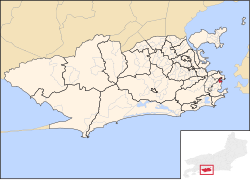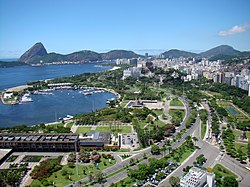Glória (Rio de Janeiro)
| Bairro da Glória Glória |
|
|---|---|
|
Glória with the marina Marina da Gloria
|
|
| Coordinates | 22 ° 55 '15 " S , 43 ° 10' 25" W |

|
|
| founding | July 29, 1981 |
| Basic data | |
| Country | Brazil |
| State | Rio de Janeiro |
| city | Rio de Janeiro |
| ISO 3166-2 | BR-RJ |
| Sub-prefecture | Zona Sul |
| Administrative region | IV Botafogo |
| surface | 1.1 km² |
| Residents | 9661 (2010) |
| density | 8,473.8 Ew. / km² |
| Time zone | UTC −3 |
Glória is a district, Portuguese bairro , in the administrative region IV Botafogo of Rio de Janeiro in Brazil . The district owes its name to the church Igreja de Nossa Senhora da Glória do Outeiro , one of the first churches in the city from the 18th century.
location
Glória is located south of the city center on the Atlantic Ocean. The middle class and the upper middle class of the Cidade maravilhosa ("Wonderful City") live here, at the northern end of Praia do Flamengo . It is considered the first quarter of the south zone of Rio and is bordered by the center ( Centro ) and the Lapa . With the construction of Flamengo Park, the area has lost much of the beauty of direct access to the sea.
With only one favela on the border with the Catete district , the residential area is largely considered to be quiet, despite countless shops, bars and restaurants. Glória also has a subway station.
history
The church Igreja de Nossa Senhora da Glória do Outeiro , today a registered cultural monument, gained a special status from the 19th century with the arrival of the Portuguese royal family in Brazil. The Prince Regent and later King Dom João VI. loved the church where he was attending mass. His successors retained a fondness for the Church. Dom Pedro I began the tradition of baptizing all the princes of the House of Braganza in the Church. The future Queen Dona Maria II , the future Emperor Dom Pedro II and Isabella of Brazil were baptized here. The Brazilian writer Lima Barreto was also baptized in the church.
Until the 1930s, the district was known as the Paris of Rio . Since the late 1880s, many hotels have been built here that served as the residences of senators who were temporarily staying in Rio de Janeiro in pursuit of their political activities. Rio de Janeiro was the capital of Brazil until 1960. Much of its architectural and urban design was inspired by Paris; B. Pariser Platz. Here, Machado de Assis created the famous Beethoven Club with other artists, musicians and personalities to hear the works of the German composer.
As a district, Glória has no political-administrative administrative authority of its own, together with seven other bairros ( Botafogo , Catete , Cosme Velho , Flamengo , Humaitá , Laranjeiras and Urca ) it is subordinate to the fourth administrative region of Botafogo, Portuguese Região Administrativa .
Olympic Games 2016
The Marina da Glória marina was modernized and expanded for the 2016 Olympic Games so that it can serve as a venue for the sailing competitions. The races themselves are held in the southernmost part of Guanabara Bay . The sailing competitions of the Paralympics 2016 will also be held here.
gallery
Web links
- Marina da Glória on rio2016.com
- A história do Brasil passa pelo bairro da Glória. In: gov.br. MultiRio(Brazilian Portuguese).
Individual proof
- ↑ Bairros. Prefeitura da Cidade do Rio de Janeiro, 2010, archived from the original on September 2, 2013 ; Retrieved January 5, 2014 .
- ↑ Regiões Administrativas - prefeitura.rio. In: www.rio.rj.gov.br. Prefeitura da Cidade do Rio de Janeiro, accessed July 20, 2019 (Brazilian Portuguese).
- ↑ O título de “Imperial Irmandade”. In: org.br. Outeiro da Glória, accessed July 20, 2019 (Brazilian Portuguese).







